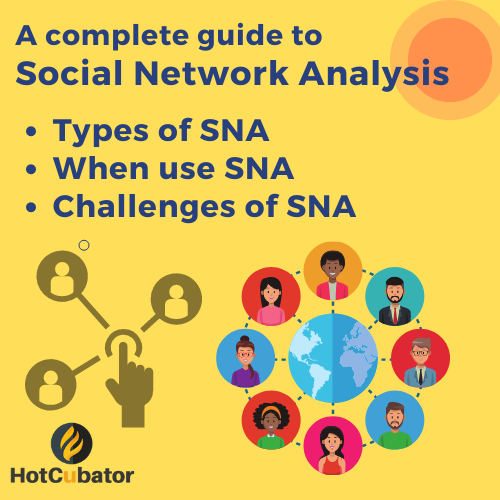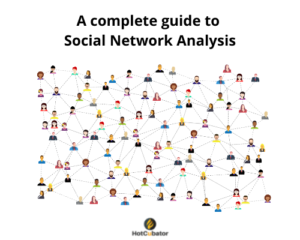
Social network analysis (SNA) is a research method used to study the relationships and connections among individuals, groups, organisations, or other entities in a social network. SNA is used to visualise and understand the patterns of relationships, communication, and influence within a network. It can be used to identify key individuals or groups, understand the spread of information or influence, and predict future behaviours and outcomes.
SNA uses a variety of techniques and tools, such as network mapping and visualisation, centrality measures, and statistical modelling, to analyse data from social networks. The data can be collected through surveys, observations, or other methods and can include information on the relationships, interactions, and attributes of the entities in the network. SNA is particularly useful in fields such as sociology, anthropology, communications, marketing, and public health, where understanding the patterns of relationships and communication within a network is important.
SNA can be used in various contexts such as:
- Identifying key individuals or groups that can act as gatekeepers or brokers within a network.
- Understanding the spread of information or influence within a network.
- Identifying potential collaborators or partners in a network.
- Understanding the dynamics of social movements or communities.
- Identifying potential areas of vulnerability or resilience in a network.
- predicting future behaviours and outcomes in a network.
Types of social network analysis
There are several types of social network analysis (SNA) that can be used to study social networks. Some of the most common types include:
- Structural analysis: This type of SNA focuses on the patterns of relationships and connections within a network. It can be used to identify key individuals or groups, understand the spread of information or influence, and predict future behaviours and outcomes.
- Actor-based analysis: This type of SNA focuses on the characteristics and attributes of the individuals or groups within a network. It can be used to understand the roles and positions of individuals or groups within a network, and to identify patterns of behaviours and communication.
- Dynamic analysis: This type of SNA focuses on the changes and evolution of a network over time. It can be used to understand how networks form, evolve, and dissolve, and to identify patterns of change and stability.
- Content analysis: This type of SNA focuses on the content of the communication within a network. It can be used to understand the topics and themes that are discussed within a network, and to identify patterns of communication and influence.
- Multilevel analysis: This type of SNA focuses on the relationships and connections between networks. It can be used to understand how networks are connected and how information or influence flows between networks.
- Spatial analysis: This type of SNA focuses on the geographic location of the individuals or groups in a network. It can be used to understand how distance and proximity affect relationships and communication within a network.
These are some of the most common types of SNA, but there are other ways to classify and analyse social networks depending on the research question and context. Researchers can use a combination of these types or adapt them to suit the specific needs of their study.
When to use social network analysis
Social network analysis (SNA) can be useful in a variety of situations and fields, including:
- Sociology: SNA can be used to study the patterns of relationships, communication, and influence within a community, group, or organization. It can also be used to understand the dynamics of social movements, and to identify key individuals or groups within a network.
- Anthropology: SNA can be used to study the patterns of relationships and communication within a culture or society, and to understand the roles and positions of individuals or groups within a network.
- Communications: SNA can be used to study the patterns of relationships and communication within a network, such as a media network or a social media network, and to understand how information is spread within a network.
- Marketing: SNA can be used to study the patterns of relationships and communication within a market or consumer network, and to identify key individuals or groups who can act as gatekeepers or brokers within a network.
- Public health: SNA can be used to study the patterns of relationships and communication within a health network, such as a disease transmission network, and to understand how information or influence spreads within a network.
- Business and management: SNA can be used to study the patterns of relationships and communication within a business network, and to identify potential collaborators or partners within a network.
- Political science: SNA can be used to study the patterns of relationships and communication within a political network, and to identify key individuals or groups who can act as gatekeepers or brokers within a network.
- Security and intelligence: SNA can be used to study the patterns of relationships and communication within a criminal or terrorist network, and to identify key individuals or groups within a network.
Key challenges in social network analysis
Social network analysis (SNA) can be a powerful research method, but it also comes with its own set of challenges. Some of the key challenges in SNA include:
- Data collection: SNA relies on accurate and complete data, which can be difficult to obtain. It can be challenging to identify all the individuals or groups in a network and to gather information about their relationships and interactions.
- Privacy and consent: SNA involves the collection of personal information, which can raise concerns about privacy and consent. Researchers must take steps to protect the privacy of participants and to obtain informed consent for their participation in the study.
- Data quality: SNA relies on accurate and reliable data, which can be affected by factors such as measurement error, missing data, and outliers. Researchers must take steps to ensure the quality of the data and to account for any potential sources of error.
- Data analysis: SNA involves the use of complex analytical methods, which can be challenging to implement and interpret. Researchers must have a good understanding of the methods and tools used in SNA and be able to apply them appropriately.
- Complexity: Social networks can be complex and dynamic, which can make it challenging to understand and analyse the patterns of relationships and communication within the network. Researchers must be able to simplify and abstract the network in a way that is meaningful and useful.
- Visualisation: SNA involves the use of network maps and visualisations to represent the relationships and connections within a network. These visualisations can be difficult to create and interpret, and researchers must be able to choose and use appropriate visualisation tools and methods.
- Generalisation: SNA is typically based on a sample of the population, and it can be challenging to generalise the findings to the larger population. Researchers must be careful when making inferences about the population based on the sample.
Further reading resources of SNA
Here are some scholarly resources where more information and knowledge on SNA can be found:
- “Social Network Analysis: An Introduction” by Linton C. Freeman, published in the Annual Review of Sociology in 2004. This article provides an overview of the history, concepts, and methods of SNA and its applications in sociology.
- “Network Analysis: An Overview” by Stanley Wasserman and Katherine Faust, published in the Social Network Analysis: Methods and Applications in 1994. This article provides a comprehensive overview of SNA, including its history, concepts, methods, and applications.
- “Network Analysis: A Handbook of Methods” by John Scott, published in the Sage Handbook of Social Network Analysis in 2011. This article provides a detailed overview of the methods and techniques used in SNA, including network mapping and visualization, centrality measures, and statistical modelling.
- “Network Analysis in the Social Sciences” by David Knoke, published in the Annual Review of Political Science in 2008. This article provides an overview of the history, concepts, and methods of SNA and its applications in the social sciences.
- “A review of the literature on network visualization” by S.A. Morris, M.D. Handcock published in Social Network Analysis and Mining, in 2011. This article reviews the literature on network visualization, including the different types of visualizations, the strengths and weaknesses of different visualization methods, and the challenges and opportunities for future research.
- “Using Social Network Analysis to Investigate the Spread of an Infectious Disease” by Jacco Wallinga and Peter Teunis, published in the Journal of the Royal Society Interface in 2009. This article provides an overview of how SNA can be used to study the spread of infectious diseases, including the methods and techniques used and the challenges and opportunities for future research.








